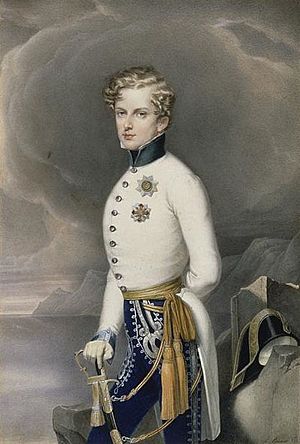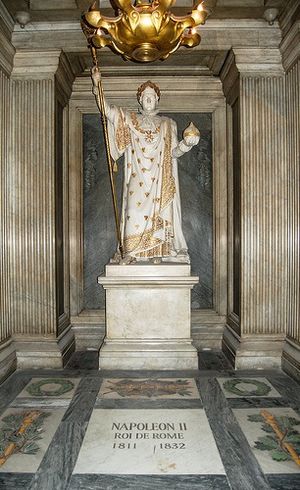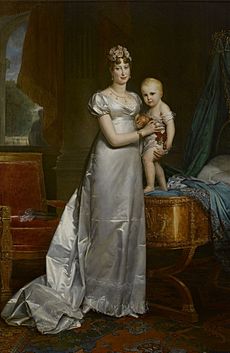Napoleon II facts for kids
Quick facts for kids Napoleon II |
|||||
|---|---|---|---|---|---|
| King of Rome Duke of Reichstadt |
|||||

Portrait by Leopold Bucher, 1832
|
|||||
| Emperor of the French (more...) (disputed) |
|||||
| Reign | 22 June – 7 July 1815 | ||||
| Predecessor | Napoleon I | ||||
| Successor | Napoleon III (1852; as Emperor) Louis XVIII (as King of France) |
||||
| Regent | Joseph Fouché | ||||
| Born | 20 March 1811 Tuileries Palace, Paris, French Empire |
||||
| Died | 22 July 1832 (aged 21) Schönbrunn Palace, Vienna, Austrian Empire |
||||
| Burial | Napoleon's tomb, Les Invalides | ||||
|
|||||
| House | Bonaparte | ||||
| Father | Napoleon I, Emperor of the French | ||||
| Mother | Marie Louise, Duchess of Parma | ||||
| Religion | Roman Catholicism | ||||
Napoleon II (Napoléon François Joseph Charles Bonaparte; 20 March 1811 – 22 July 1832) was the son of Emperor Napoleon I and Marie Louise of Austria. From birth, he was the Prince Imperial of France and King of Rome. For a few weeks in 1815, he was considered the Emperor of the French, though he never actually ruled.
After his father's power ended, he lived in Vienna, Austria. There, he was known as Franz, Duke of Reichstadt. This title was given to him by the Austrian emperor in 1818. He was later nicknamed L'Aiglon ("the Eaglet"). This name came from a popular play by Edmond Rostand.
When Napoleon I tried to give up his power in 1814, he wanted his son to become emperor. However, the countries that had defeated Napoleon did not agree. So, Napoleon I had to give up his power completely. Napoleon II never truly ruled France. He died of tuberculosis when he was 21 years old. His cousin, Louis-Napoléon Bonaparte, later became Emperor Napoleon III in 1852.
Contents
Biography
Birth and Early Life
Napoleon II was born on 20 March 1811, at the Tuileries Palace in Paris. He was the son of Emperor Napoleon I and Empress Marie Louise. On the day he was born, he had a short, traditional French baptism ceremony. A full baptism was held on 9 June 1811, in Notre-Dame de Paris.
He was cared for by Louise Charlotte Françoise de Montesquiou. She was a governess who gathered many books for him. These books were meant to teach him about religion, philosophy, and military topics.
Becoming Heir to the Throne
As the only legal son of Napoleon I, he was the official heir to the throne. The Emperor also gave him the title of King of Rome. Three years later, Napoleon I's empire fell apart. Napoleon I saw his wife and son for the last time on 24 January 1814.
On 4 April 1814, Napoleon I gave up his power. He wanted his three-year-old son to become Emperor of the French as Napoleon II. However, two days later, Napoleon I fully gave up all his rights to the French throne. The Treaty of Fontainebleau in 1814 allowed the child to use the title of Prince of Parma. His mother became the Duchess of Parma.
A Brief "Reign"
On 29 March 1814, Marie Louise and her son left the Tuileries Palace. They traveled to the Château de Rambouillet and then to the Château of Blois. On 13 April, Marie Louise and her son returned to Rambouillet. There, they met her father, Emperor Francis I of Austria. On 23 April, mother and son left France forever for Austria.
In 1815, Napoleon I returned to power for a short time. After his defeat at Waterloo, he gave up his power again. He did this in favor of his four-year-old son. A temporary government took over France for two weeks. They waited for the return of King Louis XVIII. This government never officially named Napoleon II as Emperor. On 7 July, the Allied forces entered Paris, ending any hopes for Napoleon II to rule. He was still living in Austria with his mother.
The next person from the Bonaparte family to rule France was Louis-Napoleon. He was the son of Napoleon's brother, Louis I. In 1852, he became Emperor Napoleon III.
Life in Austria
From 1814 onwards, young Napoleon lived in Austria. He was known as "Franz," which is the German version of his middle name, François. In 1818, his grandfather, Emperor Francis, gave him the title of Duke of Reichstadt.
He was taught by military teachers and loved everything about being a soldier. He even wore a small uniform like his father's. By age 8, it was clear he wanted a military career. By 1820, he had finished his basic studies. He began military training, learning German, Italian, and mathematics. He also received advanced physical training.
His official army career started at age 12, in 1823. He became a cadet in the Austrian Army. His teachers said he was smart, serious, and focused. He also grew very tall, nearly 6 feet by the time he was 17.
Some people in France tried to bring Napoleon II back to the throne in 1822. However, there is no proof that Napoleon II supported these plans. European leaders were concerned about him possibly returning to France. But he was not allowed to play any political role. Instead, Austrian leader Klemens Wenzel von Metternich used him to gain advantages for Austria.
Franz felt that his Austrian family was holding him back. He told a friend, "If Josephine had been my mother, my father would not have been buried at Saint Helena, and I should not be at Vienna."
Death
In 1831, Franz was given command of an Austrian army group. However, he never got to serve in a real battle. In 1832, he became ill with pneumonia. He was sick for several months. His health worsened, and on 22 July 1832, Franz died of tuberculosis at Schönbrunn Palace in Vienna.
He did not have any children. So, the claim to the French throne passed to his cousin, Louis-Napoléon Bonaparte. Louis-Napoléon later became Napoleon III and founded the Second French Empire.
Where His Remains Are Now

On 15 December 1940, Adolf Hitler ordered Napoleon II's remains to be moved. They were taken from Vienna to Les Invalides in Paris. This is where Napoleon I's remains had been moved in 1840. In December 1969, Napoleon II's remains were moved to a special underground area near Napoleon's tomb.
Most of his body was moved to Paris in 1940. However, his heart and intestines stayed in Vienna. This is a tradition for members of the Habsburg family. His heart is kept in Urn 42 of the Herzgruft (Heart Crypt). His other organs are in Urn 76 of the Ducal Crypt.
Legacy
- In 1900, Edmond Rostand wrote a play called L'Aiglon about his life.
- Serbian composer Petar Stojanović wrote an operetta. It was called Napoleon II: Herzog von Reichstadt and first played in Vienna in the 1920s.
- Victor Tourjansky directed a French film titled L'Aiglon in 1931. He also directed a German version.
- Arthur Honegger and Jacques Ibert worked together on an opera. It was also called L'Aiglon and premiered in 1937.
Honours
 Austrian Empire: Knight Grand Cross of the Order of Saint Stephen, 1811
Austrian Empire: Knight Grand Cross of the Order of Saint Stephen, 1811 First French Empire: Grand Eagle of the Legion of Honour
First French Empire: Grand Eagle of the Legion of Honour Kingdom of Italy: Knight of the Order of the Iron Crown, 1st Class
Kingdom of Italy: Knight of the Order of the Iron Crown, 1st Class Duchy of Parma: Knight Grand Cross of the Sacred Military Constantinian Order of Saint George
Duchy of Parma: Knight Grand Cross of the Sacred Military Constantinian Order of Saint George
Coats of Arms
-
King of Rome
(1811–14) -
Emperor of the French (titular ruler)
See also
 In Spanish: Napoleón II Bonaparte para niños
In Spanish: Napoleón II Bonaparte para niños
- Cradle of the King of Rome
- Palace of the King of Rome






